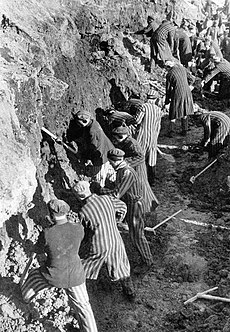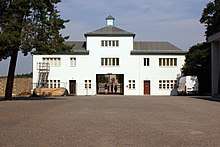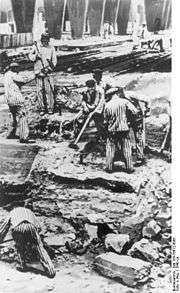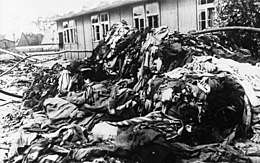Sachsenhausen concentration camp
Sachsenhausen (German pronunciation: [zaksənˈhaʊzən]) or Sachsenhausen-Oranienburg was a Nazi concentration camp in Oranienburg, Germany used from 1936 to the end of the Third Reich in May 1945. It mainly held political prisoners throughout World War II. Prominent prisoners include Joseph Stalin's oldest son Yakov Dzhugashvili, assassin Herschel Grynszpan, Paul Reynaud the penultimate Prime Minister of France, the wife and children of the Crown Prince of Bavaria, Ukrainian nationalist leader Stepan Bandera, and several enemy soldiers and political dissidents.
| Sachsenhausen | |
|---|---|
| Nazi concentration camp | |
.jpg) Prisoners of Sachsenhausen, 19 December 1938. | |
| Location | Oranienburg, Germany |
| Operated by | Schutzstaffel |
| Commandant | See list |
| Operational | July 1936–22 April 1945 |
| Inmates | Political prisoners, Jehovah's Witnesses, Soviet POWs, Poles, Jews, Homosexuals[1] |
| Number of inmates | 200,000 |
| Killed | 100,000 |
| Liberated by | Polish Army's 2nd Infantry Division |
| Notable inmates | List of prisoners of Sachsenhausen |
Sachsenhausen was a labor camp outfitted with several subcamps, a gas chamber, and a medical experimentation area. Prisoners were treated harshly, fed sparingly, and killed openly. Those held captive in Sachsenhausen were the men and women which the Third Reich wanted dead, not just because of their religion, but because of their political beliefs and their power over those who listened to them. After World War II, when Oranienburg was in the Soviet Occupation Zone, the structure was used by the NKVD as NKVD special camp Nr. 7. Today, Sachsenhausen is open to the public as a memorial for the atrocities committed within its walls.
Sachsenhausen under Nazi Germany

The camp was established in 1936. It was located 35 kilometres (22 mi) north of Berlin, which gave it a primary position among the German concentration camps: the administrative centre of all concentration camps was located in Oranienburg, and Sachsenhausen became a training centre for Schutzstaffel (SS) officers (who would often be sent to oversee other camps afterwards). Initially, the camp was used to perfect the most efficient and effective execution method for use in the death camps. Given this, executions obviously took place at Sachsenhausen, especially of Soviet prisoners of war. During the earlier stages of the camp's existence the executions were done by placing the prisoner in a small room, often even with music playing, called the Genickschussbaracke and told they were to have their height and weight measured, but were instead shot in the back of the neck through a sliding door located behind the neck.[2] This was found to be far too time-consuming so they then trialled a trench, killing either by shooting or by hanging. While this more easily enabled group executions, it created too much initial panic among the prisoners, making them harder to control. So, still not happy, they then started doing small scale trials of what would go on to become the large scale, infamous, death camp gas chambers. These trials were successful and showed them that this method was "the one" as it facilitated the means to kill the largest number of prisoners, without "excessive" initial panic. So by September 1941, when they were conducting the first trials of this method at Auschwitz, Sachsenhausen had already been the scene of "some gassings in conjunction with the development of gas vans".[3]
The prisoners were also used as a workforce, with a large task force of prisoners from the camp sent to work in the nearby brickworks to meet Albert Speer's vision of rebuilding Berlin.[4]
Camp layout

The Main gate or Guard Tower "A", with its 8mm Maxim machine gun, the type used by the Germans in the trenches of World War I, housed the offices of the camp administration. On the front entrance gates to Sachsenhausen is the infamous slogan Arbeit Macht Frei ("work makes (you) free"). About 200,000 people passed through Sachsenhausen between 1936 and 1945. Anchoring the base of the triangular shaped thousand-acre site was the large Appellplatz, where tens of thousands of prisoners would line up for morning and evening roll call. Creating a semi circular configuration, were the barracks of custody zone which fanned out from the base of the Appellplatz.
Sachsenhausen was intended to set a standard for other concentration camps, both in its design and the treatment of prisoners. The camp perimeter is, approximately, an equilateral triangle with a semi circular roll call area centered on the main entrance gate in the boundary running northeast to southwest. Barrack huts lie beyond the roll call area, radiating from the gate. The layout was intended to allow the machine gun post in the entrance gate to dominate the camp, but in practice it was necessary to add additional watchtowers to the perimeter. The standard barrack layout was to have a central washing area and a separate room with toilet bowls and a right and left wing for overcrowded sleeping rooms.
There was an infirmary inside the southern angle of the perimeter and a camp prison within the eastern angle. There was also a camp kitchen and a camp laundry. The camp's capacity became inadequate and the camp was expanded in 1938 by a new rectangular area (the "small camp") northeast of the entrance gate and the perimeter wall was altered to enclose it. There was an additional area (Sonderlager) outside the main camp perimeter to the north; this consisted of two huts Sonderlager 'A' and 'B' built in 1941 for special prisoners that the regime wished to isolate.[5]
Custody zone
The camp was secure and there were few successful escapes. The perimeter consisted of a 3-metre-high (9.8 ft) stone wall on the outside. Within that there was a space that was patrolled by guards and dogs; it was bordered on the inside by a lethal electric fence; inside that was a gravel "death strip" forbidden to the prisoners. Any prisoner venturing onto the "death strip" would be shot by the guards without warning. Officers would also force prisoners to cross this strip at gun point and threaten to kill them if they did not; the prisoner would cross the death strip and be killed anyway. Rewards such as extra leave were offered to guards who successfully shot and killed any prisoner who entered into the death zone.[6]
Slave labour

Sachsenhausen was the site of Operation Bernhard, one of the largest currency counterfeiting operations ever recorded. The Germans forced inmate artisans to produce forged American and British currency, as part of a plan to undermine the British and American economies, courtesy of Sicherheitsdienst (SD) chief Reinhard Heydrich. Over one billion pounds in counterfeit banknotes were recovered. The Germans introduced fake British £5, £10, £20 and £50 notes into circulation in 1943: the Bank of England never found them. Plans had been made to drop British pounds over London by plane.[7] Today, these notes are considered very valuable by collectors.
An industrial area, outside the western camp perimeter, contained SS workshops in which prisoners were forced to work; those unable to work had to stand at attention for the duration of the working day. Heinkel, the aircraft manufacturer, was a major user of Sachsenhausen labour, using between 6,000 and 8,000 prisoners on their He 177 bomber. Although official German reports claimed the prisoners were "working without fault", some of these aircraft crashed unexpectedly around Stalingrad and it is suspected that prisoners had sabotaged them.[8] Other firms included AEG and Siemens. Prisoners also worked in a brick factory, which some say was supposed to supply the building blocks for Hitler's dream city, Welthauptstadt Germania, which was to be the capital of the world once the Nazis took over.
Prisoner abuses
Camp punishments could be harsh. Some would be required to assume the "Sachsenhausen salute" where a prisoner would squat with his arms outstretched in front. There was a marching strip around the perimeter of the roll call ground, where prisoners had to march over a variety of surfaces, to test military footwear; between 25 and 40 kilometres (16 and 25 mi) were covered each day. Prisoners assigned to the camp prison would be kept in isolation on poor rations and some would be suspended from posts by their wrists tied behind their backs (strappado). In cases such as attempted escape, there would be a public hanging in front of the assembled prisoners. Prisoners of war were made to run up to 40 km a day with heavy packs, sometimes after being given performance-boosting drugs like cocaine, to trial military boots in tests commissioned by shoe factories.[9]
Wolfgang Wirth did experiments using the lethal sulfur mustard gas.[10][11]

There have also been allegations of an experimental drug tested upon unwilling inmates in 1944 designated "D-IX"[12] at the Sachsenhausen facility. Designed to increase stamina and endurance, this drug, supposedly consisting of a cocktail of cocaine, methamphetamine (Pervitin), and oxycodone (Eukodal),[13] was designed to see use from members of the Wehrmacht, Kriegsmarine and Luftwaffe to enhance mission performance where longevity and exhaustion become pertinent issues. While these drugs were used in their individual forms by all branches of the German military, the nature and use there of D-IX specifically (especially experimentation upon Sachsenhausen prisoners) lacks enough substantiation to be considered credible, though experiments by the Nazis upon unwilling prisoners utilizing psychoactive compounds is far from myth, and could hardly be ruled outside the realm of plausibility.
Seven men of the British Army's No. 2 Commando, captured after the highly successful Operation Musketoon, were executed at Sachsenhausen. They were shot on 23 October 1942, five days after Adolf Hitler issued his commando order calling for the killing of all captured members of commando units.
Four SOE agents led by Lt Cdr Mike Cumberlege RNR, who took part in the 1943 Operation Locksmith in Greece intended to blow up the Corinth Canal and were captured in May 1943, were held in Sachsenhausen's infamous Zellenbau isolation cells for more than a year before being executed in February/March 1945. [14]
Survivors of Operation Checkmate, a 1942 commando anti-shipping operation in Norway, including their leader, John Godwin, RN, were held at Sachsenhausen until February 1945, when they were executed. Godwin managed to wrestle the pistol of the firing party commander from his belt and shot him dead before being himself shot.
The Zellenbau contained about 80 cells and included some of World War II's most persistent Allied escapees as well as German dissidents, Nazi deserters and nationalists from East Europe such as the Ukrainian leader Tara Bulba-Borovets who the Nazis hoped to persuade to change sides and fight the Soviets[15]
Aftermath
At least 30,000 inmates died in Sachsenhausen from causes such as exhaustion, disease, malnutrition and pneumonia, as a result of the poor living conditions. Many were executed or died as the result of brutal medical experimentation. Over the course of its operation, over 100 Dutch resistance fighters were executed at Sachsenhausen. Dutch Freemasons were also sent to the camp including the Grand Master of the Grand Orient of the Netherlands, Hermannus Van Torgeren, who died there in March 1940, after being arrested by Klaus Barbie.[16] The Dutch subsequently sought the extradition from Czechoslovakia of Antonín Zápotocký, who became President of Czechoslovakia, for his alleged role in the murder of Dutch prisoners during his time as a kapo at the camp. According to an article published on 13 December 2001 in The New York Times, "In the early years of the war the SS practiced methods of mass killing there that were later used in the Nazi death camps. Of the roughly 30,000 wartime victims at Sachsenhausen, most were Russian prisoners of war".[17][18]
52.765882°N 13.264275°E

Many women were among the inmates of Sachsenhausen and its subcamps. According to SS files, more than 2,000 women lived in Sachsenhausen, guarded by female SS staff (Aufseherin). Camp records show that there was one male SS soldier for every ten inmates and for every ten male SS there was a woman SS. Several subcamps for women were established in Berlin, including in Neukölln.
Sachsenhausen female guards included Ilse Koch, and later Hilde Schlusser. Anna Klein is also noted for her presence at the camp.
Towards the end of the war, 13,000 Red Army POWs arrived at Sachsenhausen. Over 10,000 were executed in the camp by being shot in the back of the neck through a hidden hole in a wall while being measured for a uniform. Their bodies were then incinerated in a crematorium.
With the advance of the Red Army in the spring of 1945, Sachsenhausen was prepared for evacuation. On 20–21 April the camp's SS staff ordered 33,000 inmates on a forced march northwest. Most of the prisoners were physically exhausted and thousands did not survive this death march; those who collapsed en route were shot by the SS. The march ended near Raben Steinfeld on 2 May, when 18,000 remaining prisoners were liberated by tanks of the 2nd Belorussian Front. On 22 April 1945 the camp's remaining 3,000 inmates were liberated by the Red Army and the Polish Army's 2nd Infantry Division.
Camp commanders
- Michael Lippert, July 1936 – October 1936
- Karl-Otto Koch, October 1936 – July 1937
- Hans Helwig, July 1937 – January 1938
- Hermann Baranowski, February 1938 – September 1939
- Walter Eisfeld, 1939–1940
- Hans Loritz, 1940–1942
- Albert Sauer, 1942–1943
- Anton Kaindl, 1943–1945
War crimes trial
Fifteen of the concentration camp's officials, including Anton Kaindl, the former commandant, the SS camp doctor, Heinz Baumkötter, and two former prisoner kapos, including Paul Sakowski, who had served as an executioner, were brought to trial, on 23 October 1947, before a Soviet Military Tribunal in Berlin. On 1 November 1947, all seventeen were found guilty; fourteen were given life sentences with hard labor, including Kaindl, Baumkötter and Sakowski, and two were sentenced to fifteen years imprisonment with hard labor.[19]
NKVD special camp Nr. 7
In August 1945, NKVD special camp Nr. 7 was moved to the area of the former concentration camp. Nazi functionaries were held in the camp, as were political prisoners and inmates sentenced by Soviet Military Tribunals.[20] By 1948, Sachsenhausen, now renamed "Special Camp No. 1", was the largest of three special camps in the Soviet Occupation Zone. The 60,000 people interned over five years included 6,000 German officers transferred from Western Allied camps.[21] Others were Nazi functionaries, anti-Communists and Russians, including Nazi collaborators.
By the time the camp was closed in the spring of 1950, at least 12,000 had died of malnutrition and disease.[20]
With the fall of the communist East Germany it was possible to conduct excavations in the former camps. At Sachsenhausen, the bodies of 12,500 victims were found; most were children, adolescents and elderly people.[22]
The Sachsenhausen camp today

After the Soviets ceased to use Sachsenhausen as a concentration camp the site was used, for some years, by East Germany's "Kasernierte Volkspolizei", notionally a police division and in reality a precursor of the country's own National People's Army, which was formally established in 1956. 1956 was also the year in which planning began to adapt the concentration camp site as a national memorial. This was inaugurated four years later on 23 April 1961. The first director of the renamed "Sachsenhausen National Memorial Site" ("Nationale Mahn- u. Gedenkstätte Sachsenhausen") was Christian Mahler, at one time a senior police officer, who back in the Nazi period had been an inmate at Sachsenhausen between 1938 and 1943.[23] The plans involved the removal of most of the original buildings and the construction of an obelisk, statue and meeting area, reflecting the outlook of the East German government of that time.
The government of East Germany emphasised the suffering of political prisoners over that of the other groups detained at Sachsenhausen. The memorial obelisk contains eighteen red triangles, the symbol the Nazis gave to political prisoners, usually communists. There is a plaque in Sachsenhausen built in memory of the Death March. This plaque has a picture of malnourished male prisoners marching, all of whom are wearing the red triangle of a political prisoner.
As of 2015, the site of the Sachsenhausen camp, at Strasse der Nationen 22 in Oranienburg, is open to the public as a museum and a memorial. Several buildings and structures survive or have been reconstructed, including guard towers, the camp entrance, crematory ovens and the camp barracks.
After German reunification, the camp was entrusted to a foundation that opened a museum on the site. The museum features artwork created by inmates and a 30-centimetre (12 in) high pile of gold teeth (extracted by the Germans from the prisoners), scale models of the camp, pictures, documents and other artifacts illustrating life in the camp. The administrative buildings from which the entire German concentration camp network was run have been preserved and can also be seen.
Following the discovery in 1990 of mass graves from the Soviet period, a separate museum has been opened documenting the camp's Soviet-era history, in the former Sonderlager.

The compound has been vandalized by Neo-Nazis several times. In September 1992, barracks 38 and 39 of the Jewish Museum were severely damaged in an arson attack. The perpetrators were arrested, and the barracks were reconstructed by 1997. However it is important to note that the decision was taken that no buildings built during the Nazi regime will be rebuilt on the site. The destroyed section of the huts are now a Jewish museum with the surviving section left as it was immediately after the fire with the paint still blistered from the flames.[24]
Sites within Sachsenhausen and Dachau which had been approved for inclusion in the augmented reality smartphone game Ingress were removed in July 2015; Gabriele Hammermann, director of the memorial site at Dachau, told the Deutsche Presse-Agentur that Google's actions were a humiliation for victims and relatives of the Nazi camps, and Niantic Labs' founder John Hanke stated that "we apologize that this has happened."[25]
See also
Footnotes
- https://journals.plos.org/plosone/article?id=10.1371/journal.pone.0176007
- "The Extraordinary Life of Mike Cumberlege SOE by Robin Knight ISBN 978-1-78155-732-7
- "The gas Chamber at Sachsenhauden"
- Niven, Bill (2002). Facing the Nazi Past (1st ed.). Routledge. p. 11.
- Wachsmann, Nikolaus (3 March 2016). KL: A History of the Nazi Concentration Camps. ISBN 978-1-4087-0774-6.
- "History of Sachsenhausen". Jewish Virtual Library.
- Lebor, Adam; Boyes, Roger (2000). Surviving Hitler (1st ed.). Simon & Schuster. p. 230.
- "Use of Prisoners in the aircraft industry (translated)". Nazi Conspiracy and Aggression Volume IV. The Avalon Project at Yale Law School. 1996–2007. Retrieved 25 February 2008.
- Philip Ball. Naming the victims of Nazi medicine, NEJM Volume 389, No. 10085, p2182–2183, 3 June 2017 03 June 2017, DOI: https://dx.doi.org/10.1016/S0140-6736(17)31492-7showArticle Info
- Ernst Klee: the person lexicon to the Third Reich. Who was what before and after 1945 S. Fischer Verlag, Frankfurt am Main 2003, p. 681.
- Florian Schmalz: Weapon research in Nazi Germany. The cooperation of the Kaiser Wilhelm companies, military and industry. Göttingen 2005, ISBN 3-89244-880-9. Available online: Weapon research
- Vasagar, Jeevan (19 November 2002). "Nazis tested cocaine on camp inmates". The Guardian – via www.theguardian.com.
- D-IX
- Knight, Robin (2018). The Extraordinary Life of Mike Cumberlege SOE. Fonthill Media. ISBN 978-1-78155-732-7.
- T. Bulba-Borovets, Army Without a State: a Memoir - Winnipeg, 1981)
- Cooper, Robert (2011). The Red Triangle – A History of Anti-Masonry. p. 97. ISBN 9780853183327.
- At his war crimes trial in 1947 the last camp commandant, Anton Kaindl, acknowledged 42,000 deaths during his time in charge 1942-45. The exact figure will never be known as all camp records were destroyed before Soviet forces liberated Sachsenhausen in April 1945. "Title unknown". Archived from the original on 22 January 2015.
- Evans, Richard J (2006). The Third Reich in Power. London: Penguin Books. pp. 255–256. ISBN 978-0-14-100976-6.
- "Nazi War Crimes Trials: Sachsenhausen Trial". Jewish Virtual Library. Retrieved 21 January 2019.
- "The Soviet special camp No.7 / No. 1 1945 - 1950". Archived from the original on 24 September 2015. Retrieved 24 August 2012.
- Butler, Desmond (17 December 2001). "Ex-Death Camp Tells Story of Nazi and Soviet Horrors". The New York Times. Retrieved 24 August 2012.
- Kinzer, Stephen (24 September 1992). "Germans Find Mass Graves at an Ex-Soviet Camp". The New York Times. Retrieved 24 August 2012.
- Bernd-Rainer Barth. "Mahler, Christian * 12.11.1905, † 30.5.1966 Direktor der Nationalen Mahn- u. Gedenkstätte Sachsenhausen". Bundesstiftung zur Aufarbeitung der SED-Diktatur: Biographische Datenbanken. Retrieved 22 December 2014.
- Mangasarian, Leon (29 August 1993). "Swastikas desecrate Sachsenhausen concentration camp memorial". United Press International. Retrieved 24 August 2012.
- "Google Subsidiary Sorry For Including Death Camps in Phone Game". NBC News.
References
- Pingel, Falk, ed. (1990). Encyclopaedia of the Holocaust. 4. New York: Macmillan. pp. 1321–1322. Photo
- "General information on the Sachsenhausen concentration camp". web site of the "Brandenburg Memorial Foundation: Memorial and Museum Sachsenhausen". Archived from the original on 9 March 2005.
- Foot, M. R. D.; Langley, J. M. (1979). MI9 – Escape and Evasion 1939–1945. Book Club Associates. ISBN 978-0-316-28840-8.
Further reading
- Finn, Gerhard (1988). Sachsenhausen 1936–1950 : Geschichte eines Lagers. Bad Münstereifel: Westkreuz-Verlag. ISBN 978-3-922131-60-1.
- Andrea Riedle: Die Angehörigen des Kommandanturstabs im KZ Sachsenhausen. Sozialstruktur, Dienstwege und biografische Studien, Metropol Verlag, Berlin 2011, ISBN 978-3-86331-007-3

- KL - a History of Nazi Concentration Camps by Nikolaus Wachsmann, Little Brown, 2015 ISBN 978-1-4087-0774-6
- The Extraordinary Life of Mike Cumberlege SOE by Robin Knight, FonthillMedia, 2018, ISBN 978-1-78155-732-7
External links
| Wikimedia Commons has media related to Sachsenhausen concentration camp. |
- History of the Sachsenhausen-Oranienburg camp on the Jewish Virtual Library part of the American-Israeli Cooperative Enterprise
- Sachsenhausen among the Nazi camps (Germany), with list of its subcamps on a site is hosted by JewishGen, Inc
- Gedenkstätte und Museum Sachsenhausen
- Guide to the Concentration Camps Collection at the Leo Baeck Institute, New York, NY. Contains lists of prisoners and correspondence from Sachsenhausen.
- Nazi concentration camps on YouTube
- Catalog of Pins and Medals Commemorating the Sachsenhausen Concentration Camp
- [kz http://www.stiftung-bg.de/totenbuch/main.php kz sACHSENHAUSEN dEATH RECORD]
